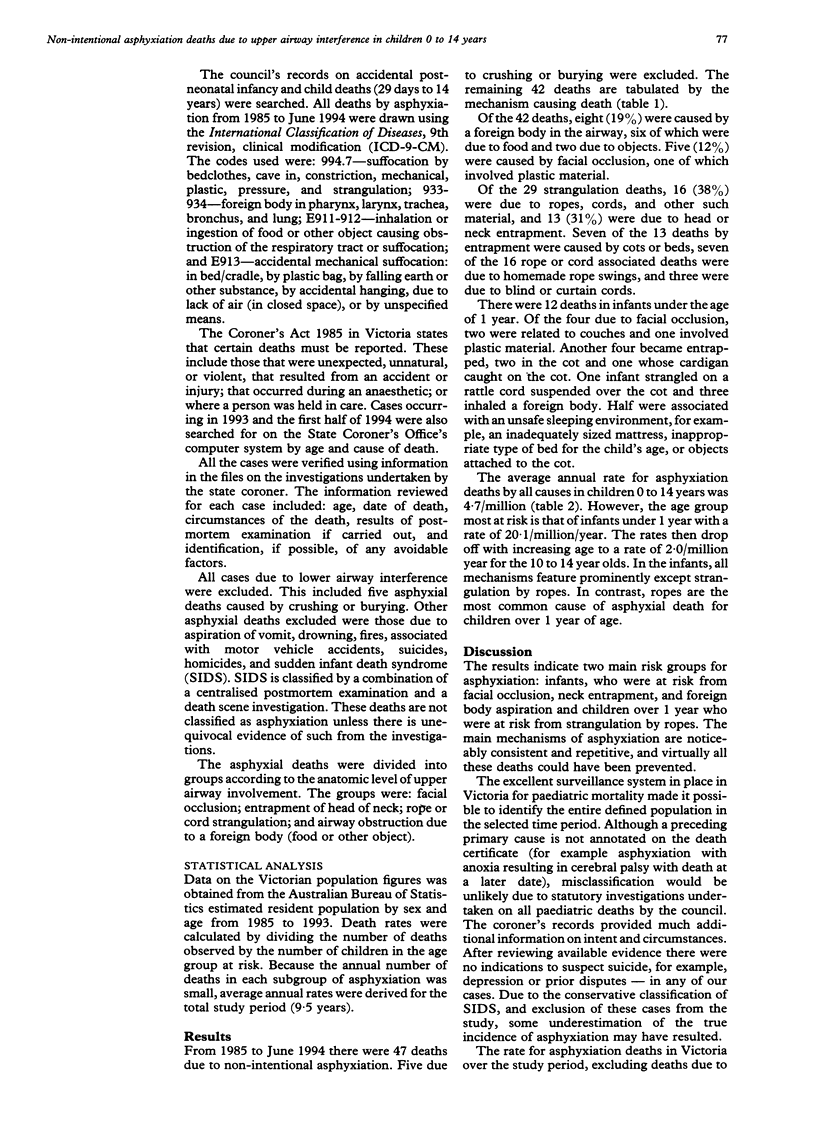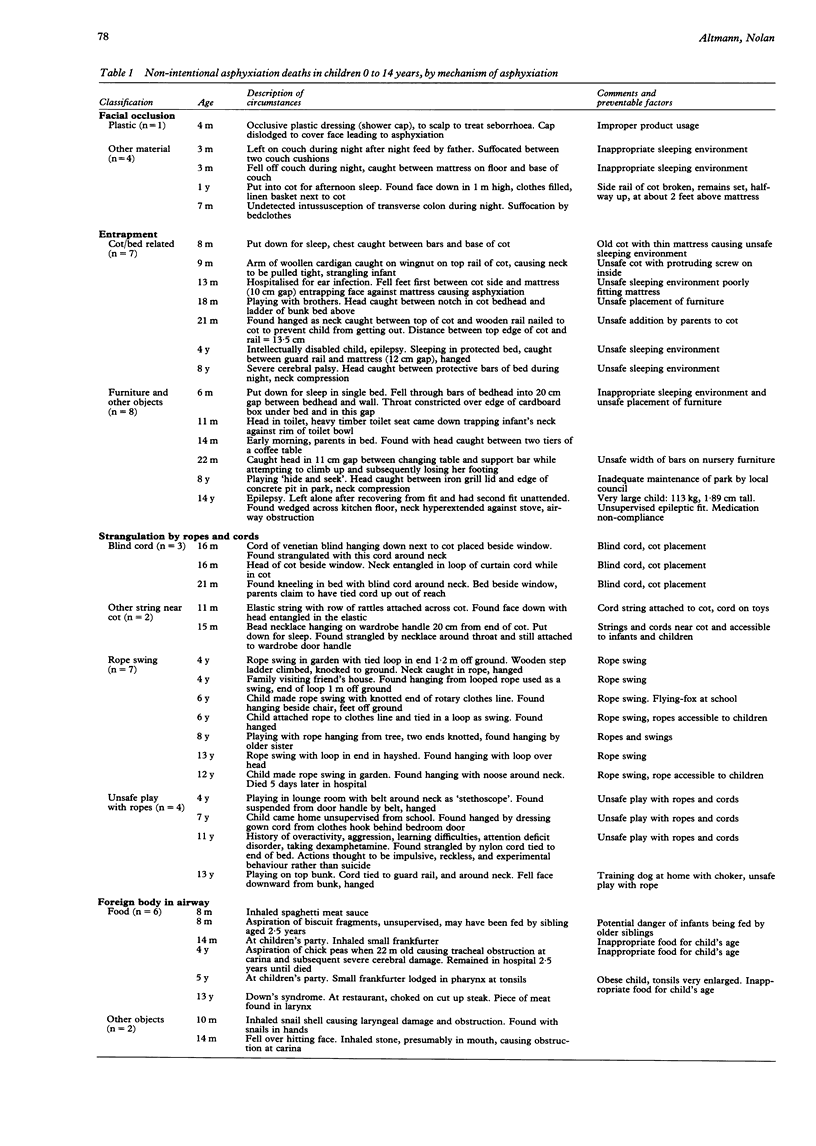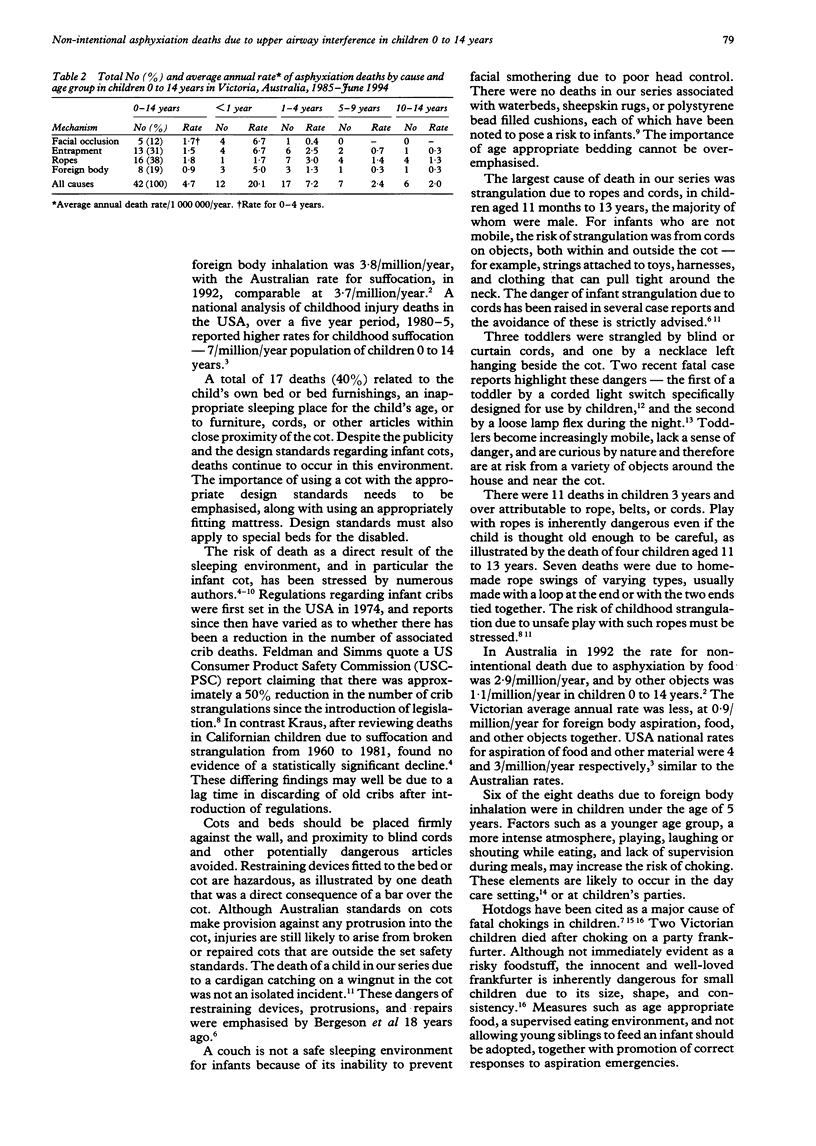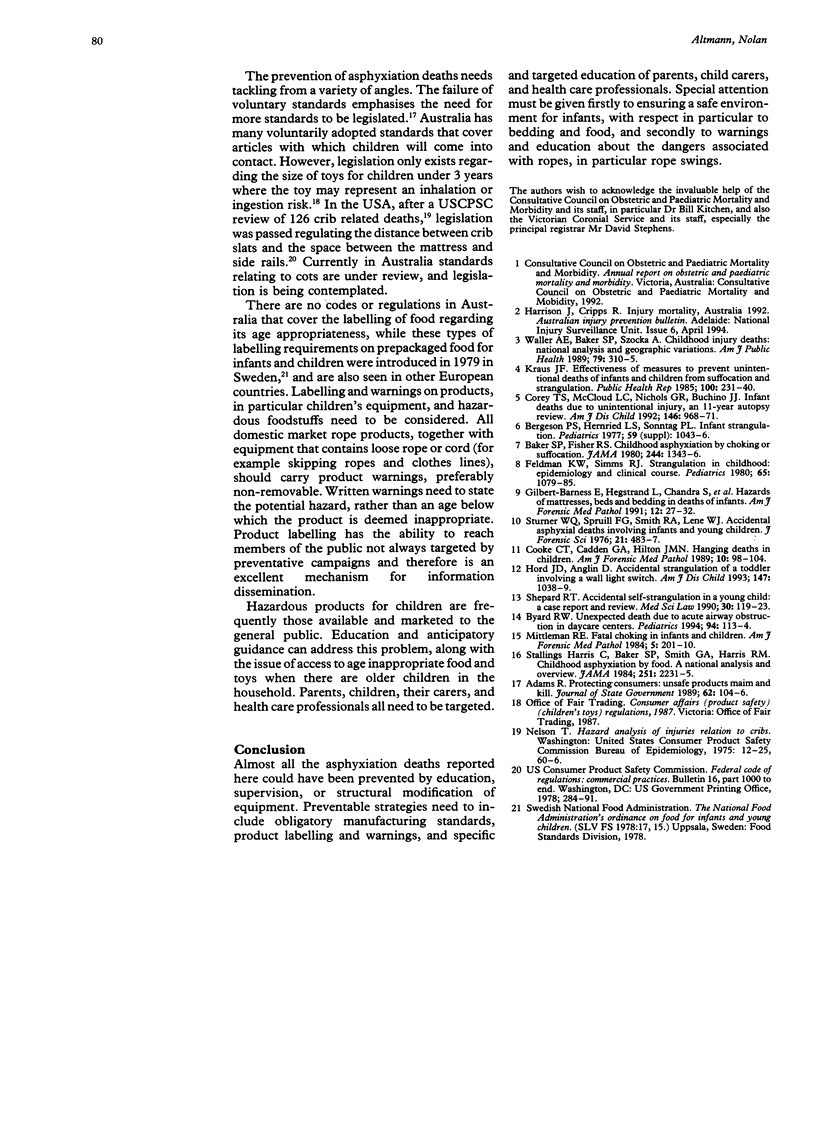Abstract
OBJECTIVE: This study was undertaken to identify avoidable, contributing factors associated with non-intentional asphyxiation deaths due to upper airway interference in children 0 to 14 years. DESIGN: Historical population based incidence study. METHODS: All postneonatal and childhood deaths by asphyxiation from 1985 to 1994, using appropriate ICD-9-CM codes, were compiled from the Victorian government legislated paediatric mortality surveillance system. Recent cases were identified from the State Coroner's Office. Case definition included children under 15 years who died from upper airway interference such as facial occlusion, head and neck entrapment, rope or cord strangulation, or foreign body. RESULTS: Of the identified 42 deaths, eight (19%) were caused by a foreign body in the airway, five (12%) were due to facial occlusion, 16 (38%) were due to ropes and similar material (seven were homemade rope swings), and 13 (31%) were caused by entrapment (seven were in cots or beds). The average annual rate for asphyxiation deaths by all causes for children 0 to 14 years was 4.7 million. Infants under 1 year had a rate of 20.1/million, while the rate for 10 to 14 year olds dropped to 2.0/million. CONCLUSION: Rope swings and rope material are inherently dangerous and frequently prove fatal, especially for older children. For infants, environmental factors are important; in particular food and bedding. Prevention strategies need to be developed that include obligatory standards for the design and manufacture of products for children, appropriate labelling and warnings, and education for children, their carers, and health care professionals.
Full text
PDF




Selected References
These references are in PubMed. This may not be the complete list of references from this article.
- Baker S. P., Fisher R. S. Childhood asphyxiation by choking or suffocation. JAMA. 1980 Sep 19;244(12):1343–1346. [PubMed] [Google Scholar]
- Bergeson P. S., Hernried L. S., Sonntag P. L. Infant strangulation. Pediatrics. 1977 Jun;59 (Suppl)(6 Pt 2):1043–1046. [PubMed] [Google Scholar]
- Byard R. W. Unexpected death due to acute airway obstruction in daycare centers. Pediatrics. 1994 Jul;94(1):113–114. [PubMed] [Google Scholar]
- Cooke C. T., Cadden G. A., Hilton J. M. Hanging deaths in children. Am J Forensic Med Pathol. 1989 Jun;10(2):98–104. doi: 10.1097/00000433-198906000-00003. [DOI] [PubMed] [Google Scholar]
- Corey T. S., McCloud L. C., Nichols G. R., 2nd, Buchino J. J. Infant deaths due to unintentional injury. An 11-year autopsy review. Am J Dis Child. 1992 Aug;146(8):968–971. doi: 10.1001/archpedi.1992.02160200090035. [DOI] [PubMed] [Google Scholar]
- Feldman K. W., Simms R. J. Strangulation in childhood: epidemiology and clinical course. Pediatrics. 1980 Jun;65(6):1079–1085. [PubMed] [Google Scholar]
- Gilbert-Barness E., Hegstrand L., Chandra S., Emery J. L., Barness L. A., Franciosi R., Huntington R. Hazards of mattresses, beds and bedding in deaths of infants. Am J Forensic Med Pathol. 1991 Mar;12(1):27–32. doi: 10.1097/00000433-199103000-00004. [DOI] [PubMed] [Google Scholar]
- Harris C. S., Baker S. P., Smith G. A., Harris R. M. Childhood asphyxiation by food. A national analysis and overview. JAMA. 1984 May 4;251(17):2231–2235. [PubMed] [Google Scholar]
- Hord J. D., Anglin D. Accidental strangulation of a toddler involving a wall light switch. Am J Dis Child. 1993 Oct;147(10):1038–1039. doi: 10.1001/archpedi.1993.02160340024006. [DOI] [PubMed] [Google Scholar]
- Kraus J. F. Effectiveness of measures to prevent unintentional deaths of infants and children from suffocation and strangulation. Public Health Rep. 1985 Mar-Apr;100(2):231–240. [PMC free article] [PubMed] [Google Scholar]
- Mittleman R. E. Fatal choking in infants and children. Am J Forensic Med Pathol. 1984 Sep;5(3):201–210. doi: 10.1097/00000433-198409000-00003. [DOI] [PubMed] [Google Scholar]
- Shepherd R. T. Accidental self-strangulation in a young child--a case report and review. Med Sci Law. 1990 Apr;30(2):119–123. doi: 10.1177/002580249003000207. [DOI] [PubMed] [Google Scholar]
- Sturner W. Q., Spruill F. G., Smith R. A., Lene W. J. Accidental asphyxial deaths involving infants and young children. J Forensic Sci. 1976 Jul;21(3):483–487. [PubMed] [Google Scholar]
- Waller A. E., Baker S. P., Szocka A. Childhood injury deaths: national analysis and geographic variations. Am J Public Health. 1989 Mar;79(3):310–315. doi: 10.2105/ajph.79.3.310. [DOI] [PMC free article] [PubMed] [Google Scholar]


